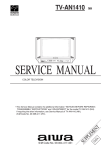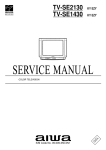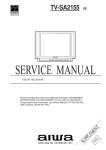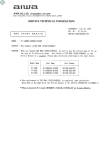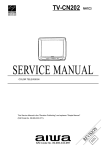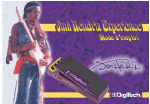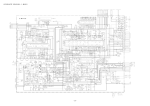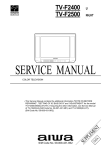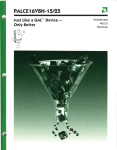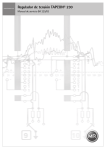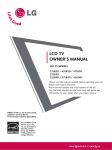Download Aiwa TV-SA2151 Service manual
Transcript
TV-SA2151 SHR SERVICE MANUAL COLOR TELEVISION S/M Code No. 09-007-420-8S1 SU PP LE ME DA NT TA • This Service Manual contains the additional information “NOTICES BEFORE REPAIRING”, “DISASSEMBLY INSTRUCTIONS” and “ADJUSTMENT” for the model TV-SA2151 (SHR). If requiring the other information, see Service Manual of TV-SA2151 <SHR>, (S/M Code No. 09-001-420-8R1). NOTICES BEFORE REPAIRING To make the best use of this equipment, make sure to obey the following items when repairing (or mending). 1. Do not damage or melt the tunicate of the leading wire on the AC1 side, including the power supply cord. 2. Do not soil or stain the letters on the spec. inscription plates, notice labels, fuse labels, etc. 3. When repairing the part extracted from the conducted side of the board pattern, fix it firmly with applying bond to the pattern and the part. 4. Restore the following items after repairing. 1) Conditions of soldering of the wires (especially, the distance on the AC1 side). 2) Conditions of wiring, bundling of wires, etc. 3) Types of the wires. 4) Attachment conditions of all types of the insulation. 5. After repairing, always measure the insulation resistance and perform the voltage-withstand test (See Fig-1). 1) The insulation resistance must be 1 MΩ when applying 500V per second. 2) In the voltage withstand test, apply 1 kV for 1 min and check that the GO lamp lights. * * * * Insulation resistance: 1 MΩ (500 V/s) Voltage-withstand: 1 kV for 1 min Safety checker (Model 7110, etc.) Earth cable AC cable Connect the earth cable to the outside metal part terminal. Fig-1 Breaking current set to 10 mA. Connect the safety checker as shown in Fig-1, then measure the resistance and perform the test. Do not touch the equipment during testing. For details of the safety checker, refer to the supplied Operation manual. When servicing and checking on the TV, note the followings. 1. Keep the notices. As for the places which need special attentions, they are indicated with labels or seals on the cabinet, chassis and parts. Make sure to keep the indications and notices in the operation manual. 2. Avoid an electric shock. There is a high voltage part inside. Avoid an electric shock while the electric current is flowing. 3. Use the designated parts. The parts in this equipment have the specific characteristics of incombustibility and withstand voltage for safety. Therefore, use a part which has the same character as the replaced part. Especially as to the important parts for safety which is indicated in the circuit diagram or the table of parts with a ! mark, the designated parts must be used. 4. Put parts and wires in the original position after assembling or wiring. There are parts which use the insulation material such as a tube or tape for safety, or which are assembled so that these parts do not make contact with the printed ! board. The inside wiring is designed not to get close to the pyrogenic parts and high voltage parts. Therefore, put these parts in the original positions. 5. Take care of the cathode-ray tube. By setting an explosion-proof cathode-ray tube in this equipment, safety is secured against implosion. However, when removing it or servicing from the back, it gives out shock that is dangerous. Take enough care to deal with it. 6. Avoid an X-ray. Safety is secured against an X-ray by giving considerations to the cathode-ray tube and the high voltage peripheral circuit, etc. Therefore, when repairing the high voltage peripheral circuit, use the designated parts and do not change the circuit. Repairing, except indicates, causes rising of high voltage, and the cathode-ray tube emits an X-ray. 7. Perform a safety check after servicing. Confirm that the screws, parts and wiring which were removed in order to service are put in the original positions, or whether there are deteriorated portions around the places serviced. Safety Components Symbol This symbol is given to important parts which serve to maintain the safety of the product, and which are made to confirm to special Safety Specifications. Therefore, when replacing a component with this symbol make absolutely sure that you use a designated part. –2– DISASSEMBLY INSTRUCTIONS 1. REAR CABINET REMOVAL (1) Remove four screws 1 and three screws 2 , then remove the rear cabinet in the direction of the arrow. (See Figure1-1) Front cabinet Rear cabinet Figure 1-1 2. HIGH-VOLTAGE CAP (ANODE CAP) REMOVAL 2-1. Cautions before Removing Anode cap Discharge the anode voltage (1) The anode voltage is not discharged completely from the CRT of this unit even after the power is turned off. Be sure to discharge the residual anode voltage before removing the anode cap. CRT GND Do not use pliers (2) Do not use pliers, etc. to remove the anode cap. If you used pliers and bent the hook to remove the cap, the spring characteristics of the hook could be lost, and when reinstalled, the cap would come off from the CRT anode button easily, causing an accident. (3) If the anode cap is turned in the direction of its circumference, the hook is likely to come off. Do not turn the anode cap Grip CRT Hook CRT GND Figure 2-1 2-2. Anode Cap Removal (1) (2) (3) (4) Discharge the anode voltage. (See Figure 2-1) Connect a flat-bladed screwdriver to the CRT GND via an alligator clip. Use a tester to check the end of the screwdriver and ground of the TV for continuity. Touch the hook with the end of the screwdriver. Caution : Be careful not to damage the anode cap. Turn over the anode cap. Caution : Be careful not to damage the anode cap. Anode cap CRT Anode button Hook Figure 2-2 –3– (5) Push the anode cap with your thumb in the direction of arrow 1 as shown in the figure, then lift the cap in the direction of arrow 2 to release the hook on one side. (See Figure 2-3) Anode cap CRT CRT Hook Hook Figure 2-3 (6) Turn over the anode cap on the side where the hook was released and pull out the cap in the direction opposite to that on which the cap was pushed. (See Figure 2-4) Caution : Do not pull out the anode cap straight up. : Do not pull the cap forcibly. After removing the cap, check that the hook is not deformed. Anode cap CRT Anode button Hook Figure 2-4 3. ANODE CAP REINSTALLTION Anode cap Observe the cautions carefully so that no accident occurs due to a defect in installing the anode cap and so it does not come off. Left Right 3-1. Caution before Reinstalling Never turn the anode cap after installing it Never re-use the hook when it has been deformed (1) (2) If the anode cap is turned after it is installed, it may come off. Therefore, arrange the high-voltage cable before attaching the anode cap. (See Figure 3-1) If you have attached the anode cap before arranging the high-voltage cable, arrange the cable carefully so the cap does not turn. Figure 3-1 3-2. Anode cap reinstallation Anode button (1) (2) Use a clean cloth moistened slightly with alcohol to clean the installation section. (See Figure 3-2) Caution : Check that the installation section is free from dust, foreign matter, etc. Coat the anode cap installation circumference with an appropriate amount of the specified silicone grease (KS650N). Caution : Be careful that silicone grease does not enter the anode button. Installation section Figure 3-2 –4– (3) Eliminate twisting, etc. of the high-voltage cable and arrange it so that no twisting occurs. (See Figure 3-3) Caution : If the cable is not arranged correctly, the anode cap could turn and cause an installation defect. High-voltage cable Anode cap Figure 3-3 (4) Turn over the rubber cap symmetrically on the left and right. (See Figure 3-4) Caution : Take great care not to damage the anode cap. Figure 3-4 (5) Fit your forefinger over the projection at the center of the cap and hold the cap between your thumb and middle finger. (See Figure 3-5) Figure 3-5 –5– (6) (7) Apply the hook on one side to the anode button as shown on the figure. (See Figure 3-6) Caution : Check that the hook is held securely. Apply the hook on the other side to the anode button as shown in Figure 3-7. Hook Anode button Hook Anode button 30° Figure 3-6 Anode button Hook Figure 3-7 (8) Pull the anode cap slightly with the rubber cap turned over and visually check that the hook is engaged securely. (9) Release your hand from the rubber cap of the anode cap. Caution : Cover the anode cap so that it does not lift. (10) Hold the skirt of the andoe cap slightly to improve the close contact between the cap and CRT. (11) Check that the anode cap is in close contact with the CRT. (See Figure 3-8) Anode button Skirt Figure 3-8 –6– 4. NK C.B. (PWB, NK) REMOVAL (1) (2) (3) Disconnect CN553 (CRT GND). Disconnect CN551, CN552 Remove the NK C.B. in the direction of arrow 1. (See Figure 4-1) Front cabinet CN801 (Power Cord) 5. MAIN C.B (PWB, MAIN) REMOVAL (1) (2) (3) (4) Remove connector (CN901). Remove connector (CN801). Remove connector (CN802). Pull out the MAIN C.B. in the direction of the arrow 2 (See Figure 4-1). CN802 (Degauss cord) NK C.B CN552 MAIN C.B CN551 CN553 CN901 (Speakers) Figure 4-1 –7– ADJUSTMENT Set-Up For Adjustment 1. CRT Adjustment 1-1. Precautions Because the video signal output from a pattern generator is used as the adjustment signal input during adjustment, the video signal output from the pattern generator must conform with the specifications. Measure the output waveform across 75 Ω load. Confirm that the synchronizing signal has an amplitude of about 0.3 V, the video signal portion has an amplitude of about 0.7 V and the burst signal has an amplitude of about 0.3 V with flat envelope. Confirm that ratio of the burst signal amplitude and the red signal amplitude is 0.30 : 0.66. If the output signal does not conform with the specifications, calibrate the pattern generator. (Refer to pattern generator operation manual.) Use the LEADER: LCG 404 for the pattern generator. (1) Receive the white raster signal, and then perform aging for at least 20 minutes. (2) Demagnetize the area surronding the CRT with a degausser before making adjustments. (3) Set the picture quality for each mode to the factory setting. (4) Position the front screen facing the east as much as possible. 1-2. Purpose (1) Beam landing adjustment (purity magnet) Set the left/right balance of beam landing. If there is a discrepancy in this adjustment, a color irregularity will occur. After completion of the landing adjustment, it is necessary to perform convergence adjustment. Approx. 0.7V 1 Vp-p White (Approx. 75%) Burst signal Before adjustment Approx. 0.3V Color irregularity Black Red Blue Magenta Cyan Fig. 1-1 Green 75% white Yellow Approx. 0.3V After adjustment TV display Color bar signal of a pattern generator Precautions Before Starting Adjustment Satisfy the following setting conditions before starting adjustment. • Allow warm-up of 20 minutes or longer. (Do not turn off during warm-up.) • Set all picture quality controls of users' setting to initial set-up, unless otherwise specified. • Picture quality reset 1. Select "Picture" on the screen menu and press enter button. 2. Select "Normal" and press enter button. 3. Select "Reset" and press enter button. • Set the pattern generator’s output level to 1.0Vp-p (across 75Ω load). –8– (3) Beam convergence adjustment (6-pole magnet) With a 4-pole magnet align the G beam with the already aligned R/B beam. (2) Beam convergence adjustment (4-pole magnet) Align the R beam with the B beam. The G beam does not move with this adjustment. (magenta) (magenta) B R/B R G (white) R/B G G RGB Align the G beam with the R/B beam Fig. 1-3 Align the R beam with the B beam Fig. 1-2 (4) The composition of each magnet is as shown in Fig. 1-4. In making adjustments, rotate the lock ring clockwise (looking from the CRT’s back screen) and disengage. Be careful not to loose the lock ring too much. If the magnet assembly has become shifted during adjustments, secure it to the position in Fig. 1-4. DY lock screw Purity 4-pole 6-pole Lock ring Magnet assembly lock screw CRT DY Magnet assembly Fig 1-4 –9– NK C.B 1-3. Beam Landing Adjustment (1) Receive the green raster signal from the pattern generator. (2) Loosen the magnet lock screw, and shift the magnet assembly backward (toward the neck). (3) Loosen the DY lock screw, and shift the DY deflecting yoke backward (toward the neck). (4) After opening the two purity magnets to the same angle, adjust the color width of the bands on both sides of the screen so that they are equal. (refer to Fig. 1-5 (a)). As there is occurrence of convergence distortion after completing the landing adjustments, be sure to carry out convergence adjustments. If the color irregularities in the screen’s corner section are not improved, correct them with the landing magnet. After using the landing magnet, be sure to demagnetize the CRT with degausser and verify that there is no occurrence of color irregularity. (refer to Fig. 1-6) Landing magnet: 81-JTI-710-010 (two-sided adhesive tape) : 80-XVI-218-010 Cushion R=B R G B Fig 1-5 (a) As shown in Fig. 1-5 (b), the purity magnet functions in relation to the electron beam. Landing magnet Cushion S N N S NS SN Since the landing magnet is polarized, check the screen’s improvement through rotation, not only by position. S S N N SS Fig 1-6 NN Fig 1-5 (b) (5) Gradually shift the deflecting yoke toward the front (toward the CRT funnel). Stop movement at the point when the screen has become completely green. (6) Also, verify the respective monochromatics of red and blue. (7) While looking at the screen, adjust the tilt of the deflecting yoke and tighten the DY lock screw. (8) Shift the magnet assembly to the front (toward the CRT funnel), stop movement before the adjustment position and then tighten the magnet lock screw. At this time, be careful not to shift the position of the purity magnet. – 10 – 1-4. Beam Center Convergence Adjustment 1-5. The Surrounding Convergence Adjustment Make adjustments on the convergence with 4-pole and 6-pole magnets. Operate each magnet in relation to the electron beam as shown in Figs. 1-7 and 1-8. When performing this adjustment, verify whether there is distortion in the focus adjustment. If necessary, carry out adjustments again. Perform this adjustment after completion of adjustment 1-4. (1) Shake the deflecting yoke up, down to the right and left, and adjust any discrepancies in the screen’s surroundings. (2) Insert wedges in three locations in the gap between the deflecting yoke and the surface of the CRT funnel in order to secure the deflecting yoke. (Refer to Fig. 1-9) S S B N G B N R G R N Wedge N S S Fig 1-7 Wedge Wedge In Fig. 1-7, two 4-pole magnets are stacked together so as to be of the same polarity. Move the B and R beams to their respective direction, by rotating the two 4-pole magnets together. By adjusting the opening of the two magnets, it is possible to adjust the amount of the beam’s movement. Position of wedge N S S N Fig. 1-9 S B G R N B G R S N N S S N Fig 1-8 In Fig. 1-8, the two 6-pole magnets are stacked together so as to be of the same polarity. Move the B and R beams to their respective direction, by rotating the two 6-pole magnets together. By adjusting the opening of the two magnets, it is possible to adjust the amount of the beam’s movement. (1) Receive the dot pattern signal from the pattern generator. (2) Pay attention to the center of the screen, and perform adjustments with two 4-pole magnets so that the R beam and B beam are perfectly aligned and become a magenta color. (Refer to Fig. 1-2) (3) In the same way, pay attention to the screen, and perform adjustments with a 6-pole magnet so that the magenta beam and G beam are aligned and become a white dot. (Refer to Fig. 1-3) (4) After adjustments are completed, secure all magnets with the lock link. (Refer to Fig. 1-4) – 11 – Setting of IIC BUS Data This model is designed with the ability to adjust most parts of the image projection and deflection system by using the jig remote controller. Preparations : • Modify the hidden keys on the RC-6VT06 jig remote controller (TV-C142/86-LB4-951-010) so that they can easily be pressed. 2 keys to be modified. (Refer to the below illustration) Starting the “Service Mode” : Hidden key / “TEST” • Press the “TEST” key on the jig remote controller once to enter to the “Aging Mode” (Refer Fig. 1). • Press the “CHANNEL” key on the jig remote controller to enter to the “Adjustment Mode”. Hidden key / “FINISH” • The accumulated hours in the “Aging Mode” will be reset by pressing the “FINISH” key on the jig remote controller. • Avoid to press this key during general repairs. Aging Mode Operation Method : Make sure that confirmation is done after replacing the EEP ROM. 1. Enter to the aging mode by pressing the “TEST” key on the remote controller. (Fig. 1) Contents of Aging Mode : 1. Release “Auto Power Off” function Release “Auto Power Off” function when no input is supplied. Use this mode for warming up (aging) during CRT adjustment. 2. AFT S-curve status indication The condition of AFT S-curves are indicated by “IN” for suitable tuning, “HIGH” for too high or “LOW” for too low. “OUT” is indicated when no signal is supplied. – 12 – 3. Display of “CRT ON” accumulated hours The CRT usage time is accumulated on an hourly basis and is displayed in hexadecimal figures. Sample calculation of displayed hexadecimal figures : HEX 1 2 3 4 • The display will be reset to 0000H when the accumulated hours exceed 7FFFH(32768 hours). Adjustment Mode Operation Method : 3. Return to the aging display by pressing the “SYSTEM” key and press “TEST” key once again to enter into the adjustment menu screen. Adjustment Menu Chart PUSH CH UP/DN KEY PAGE 1 PUSH CH UP/DN KEY PAGE 3 PAGE 2 1 H POS 2 V POS – – – Blank – – – 4 OSD H 5 PIF VCO 6 RF AGC 00 00 00 00 00 1 2 3 4 5 6 00 00 00 00 00 00 R CUTOFF G CUTOFF B CUTOFF G DRIVE B DRIVE BRIGHT PUSH 1~6 KEY PUSH 1~6 KEY PAGE 1 14 H POS 15 V POS 00~07 ––––––– –– 16 00~7F OSD H 17 AFT ** 00~FF PIF VCO AGC/2 18 ** RF AGC 00~3F PUSH CH UP/DN KEY SECAM B-Y SECAM R-Y RGB CONT H SIZE V SIZE TINT 00 00 00 00 00 00 PUSH 1~6 KEY PAGE 2 00~1F 1 2 3 4 5 6 PUSH CH UP/DN KEY PAGE 3 19 R CUTOFF 00~FF 20 G CUTOFF 00~FF 21 B CUTOFF 00~FF 22 00~7F G DRIVE 23 00~7F B DRIVE 24 BRIGHT ** PUSH CH UP/DN KEY 25 SECAM B-Y 26 SECAM R-Y 27 RGB CONT 28 H SIZE 29 V SIZE 30 TINT PUSH CH UP/DN KEY 0~101 MENU * Each figure in the adjustment menu can be changed using the volume adjustment keys (+, -). Fig. 2 – 13 – ** ** ** ** ** ** The menus from No.0 to 101 inclusive of PAGE 1 to 3 serve as the “Adjustment Menu” . (Refer to the following tables) No. Menus Reference Values No. Menus Reference Values No. Menus Reference Values 0 CONT 20 34 BRIGHT STEP 00 68 H OUT STOP – 1 COLOR 10 35 BRIGHT MAX 7F 69 FORCED ID – 2 SHARPNESS 20 36 CONT MIN 00 70 SELF ADJ – 3 SUB CONTRAST 08 37 CONT MAX 3F 71 ID SENSIV – 4 V LINEA 07 38 COLOR NTSC 40 72 SECAM ADJ – 5 V S CORR 05 39 COLOR MIN 00 73 AFT ON – 6 ABL START 02 40 COLOR SECAM 04 74 YM EMB – 7 IF FEAQ 04 41 COLOR MAX 7F 75 YUV SW – 8 BGP P 00 42 RG CONT MAX 30 76 AFC GAIN 00 9 PARABOLA – 43 SHARP MIN 00 77 V LINEA 60 07 10 TRAPEZIUM – 44 SHARP MAX 3F 78 H SIZE 60 – 11 V. EHT – 45 SHARP NT 20 79 PARABOLA 60 – 12 CORNER – 46 SHARP NT VIDEO 20 80 TRAPEZIUM 60 – 13 H. EHT – 47 SHARP VIDEO 20 81 V. EHT 60 – 14 H POS 0C 48 TINT MIN 00 82 CORNER 60 – 15 V POS 04 49 TINT MAX 7F 83 H. EHT 60 – 16 OSD H 17 50 TXT RGB MAC 3A 84 V S CORR 60 06 17 PIF VCO 80 51 ABL GAIN 00 85 V SIZE 60 0B 18 RF AGC 20 52 V AGC 00 86 V POS 60 00 19 R CUTOFF 80 53 WHITE PEAK 00 87 H POS 60 0F 20 G CUTOFF 80 54 MUTE – 88 OSD H 60 14 21 B CUTOFF 80 55 AF GAIN – 89 OSD V 60 08 22 G DRV GAIN 40 56 VIDEO POL – 90 G VSIZE SHIFT 02 23 B DRV GAIN 40 57 BPF/TOF – 91 G HSIZE SHIFT 00 24 BRIGHT 40 58 CHROMA TRAP – 92 G VPOS SHIFT 00 25 SEGAM B-Y 08 59 HALF TONE – 93 G HPOS SHIFT 00 26 SEGAM R-Y 08 60 COLOR SYSTEM – 94 OSD V 09 27 RGB CONT 20 61 CW SW – 95 VOL LOUDSPK 73 28 H SIZE – 62 AFT MUTE – 96 FM MATRIX 01 29 V SIZE 20 63 BLUE BACK – 97 PRESCALE FM/AM 25 30 TINT 3F 64 DC NF SPEED – 98 PRESCALE NICAM 56 31 TEST – 65 V FREQ – 99 PRESCALE SCART 19 32 TEST 2 – 66 NTSC COMB – 100 NICAM IDL 03 33 BRIGHT MIN 00 67 BLACKING – 101 NICAM IDH 0A *1. The indicated reference values are different from the actual data values. *2. Depending on the model, all items which are described in the “Adjustment Mode” may not be always applicable. Refer to each adjustment. – 14 – Menu Screen Adjustment : • • Operate after inputting the following initial figures when replacing EEP ROM. These initial figures are only for reference purposes and meant for rough adjustment. Check the condition and adjust the area where the general repair is carried out. TV-SA2151 PAGE 1 1. H POS 2. V POS ––––– 4. OSD H 5. PIF VCO 6. RF AGC PAGE 2 1. R CUT OFF 2. G CUT OFF 3. B CUT OFF 4. G DRV GAIN 5. B DRV GAIN 6. BRIGHT PAGE 3 1. SECAM B-Y 2. SECAM R-Y 3. RGB CONT 4. H SIZE 5. V SIZE 6. TINT Sample Indication for Adjustment Menu No. Initial Figures PAL (NTSC) 0A(0D) 3(1) –– 18(17) 85 3F 7F 7F 7F 60 60 20 0C 0B 00 00 1B(18) 3F Each adjustment should be carried out after checking the adjustment menu no. (Refer to the above Fig.) Fig. 1 PAGE 1 1-1. H POS Horizontal Positioning Adjustment PAL Adjustment Menu No. 14 (Page 1-1) Input signal : Crosshatch Measuring instrument : Pattern generator / PAL • Use the volume keys on the jig remote controller to adjust the dot mark in the centre of crosshatch screen to the exact centering position by allocating an equal number of squares on the left and right side of the dot. A=B (Fig. 1-1) NTSC Adjustment Menu No. 87 Input signal : Crosshatch Measuring instrument : Pattern generator / NTSC • Using the “CHANNEL” key, scroll through the adjustment menu and select No.87. To adjust, follow the same procedure as PAL. 1-2. V POS Vertical Positioning Adjustment PAL Adjustment Menu No.15 (Page 1-2) Input signal : Crosshatch Measuring instrument : Pattern generator / PAL • Using the volume keys on the jig remote controller, adjust the dot mark to the exact vertical centre position in the crosshatch screen. (Fig. 1-2) * In case of being unable to adjust by the above mentioned procedure, adjust S501. NTSC Adjustment Menu No. 86 Input signal : Crosshatch Measuring instrument : Pattern generator / NTSC • Use the “CHANNEL” key to scroll through the adjustment menu and select No. 86. To adjust, follow the same procedure as PAL. * Do not adjust S501 for NTSC. – 15 – 1-3. OSD H OSD Horizontal Positioning Adjustment PAL Adjustment Menu No. 16 (Page 1-4) Input signal : Crosshatch Measuring instrument : Pattern generator / PAL • Use the volume keys on the jig remote controller to adjust each A and B positions on both left and right in the equal distance towards the screen edge in the OSD display. A = B (Fig. 1-3) NTSC Adjustment Menu No. 88 Input signal : Crosshatch Measuring instrument : Pattern generator / NTSC • Use the “CHANNEL” key to scroll through the adjustment menu and select No.88. To adjust, follow the same procedure as PAL. 1-4. OSD V OSD Vertical Positioning Adjustment PAL Adjustment Menu No. 94 Input signal : Crosshatch • Use the “CHANNEL” key to scroll through the adjustment menu screen and select No.94. • Using the volume keys on the jig remote controller, adjust A and B on both top and bottom shown in the OSD screen to be equidistant from the screen edges. A = B (Fig. 1-4) NTSC Adjustment Menu No. 89 Input signal : Crosshatch Measuring instrument : Pattern generator / NTSC • Use the “CHANNEL” key to scroll through the adjustment menu and select No. 89. To adjust, follow the same procedure as PAL. 1-5. PIF VCO Video IF • VCO Adjustment Adjustment Menu No.17 (Page 1-5) Input signal : No signal Test point : IC301 1 PIN AFT OUT • Use volume keys on the jig remote controller and adjust the test point voltage value to 2.5 ± 0.5VDC. 1-6. RF AGC RF - AGC Adjustment Menu No.18 (Page 1-6) Input signal : Color bar (ANT RF - INPUT) Input signal : fp = 471.25MHz Test point : IC301 1 PIN AFT OUT Measuring instrument : Oscilloscope 1. Connect oscilloscope to IC301 1 PIN. 2. Using the volume keys on the jig remote controller, set the value to [3F]. At this point, measure the voltage on the test point. 3. Use the volume keys on the jig remote controller and reduce the Fig. 1-6 value. (3E b 3D...) At this point, confirm the reduction of the test point voltage value. 4. Complete the adjustment when the difference of the voltage value when compared to [3F] becomes less than 0.2V. – 16 – PAGE 2 White Balance Adjustment : Adjustment Menu No. 19-24 (PAGE 2 - 1 to 2 - 5) *User’s picture quality will be cleared when the adjustment menu screen appears. Input Signal : White raster Contents of Adjustment : 1. R CUT OFF Contents of Adjustment : 2. G CUT OFF Contents of Adjustment : 3. B CUT OFF Contents of Adjustment : 4. G DRIVE * More than 15 minutes of aging is required 5. B DRIVE before the adjustment. * The whole process should be repeated several times for the adjustment. Measuring instrument : Pattern generator Cut Off Adjustment : 2-1. Use the pattern generator to input the white raster signal 2-2. Using the volume keys on the jig remote controller, fix the figure of the strongest color on the screen to 7F and adjust the other 2 cut off figures until a white picture appears on the screen. (Fig.2-1) Drive Adjustment : 2-3. Using the volume keys on the jig remote controller, bring the figure of the 4. G DRIVE up to more than 60 (in hexadecimal figure) till the color becomes greenish. 2-4. Then reduce the numeric figure to the point where the greenish color disappears completely. 2-5. Use the volume keys on the jig remote controller to increase the numeric figure of the 5. B DRIVE up to more than 60 (in hexadecimal figure) till the color becomes bluish. 2-6. Then reduce the numeric figure to the point where the bluish color disappears completely. 2-7. Repeat the process of 2-1 to 2-6 for several times and adjust for whiter look. BRIGHT Sub-brightness Adjustment Adjustment Menu No.24 (Page 2-6) Input signal : Stair step Measuring instrument: Pattern generator 1. Using the volume keys on the jig remote controller, adjust the scale of the second last from right to be slightly brightened. (Fig. 2-2) Focus Adjustment : Input signal : Dot pattern Adjustment point : SFR located at upper part of FBT (T601) Measuring instrument : Pattern generator • Adjust SFR which is located at upper part of FBT (T601) in order to get the best focus for the dot. Screen Adjustment : Input signal : No signal (No Raster) Adjustment point : SFR located at lower part of FBT (T601) 1. Enter to the “Aging Mode Screen” by pressing “TEST” key on the jig remote controller once. 2. Press “10” key of the numeric channel keypad to get a horizontal single line screen. (Fig. 2-3) 3. Adjust SFR located at lower part of FBT (T601) until the horizontal line starts to be slightly brightened. 4. Repeat the process of step 2 and return to the “Adjustment Menu Screen”. – 17 – PAGE 2 3-1. SECAM B - Y SECAM Video, Chroma Adjustment Adjustment Menu No. 25 (Page 3-1) Input signal : Black signal Measuring instrument : Oscilloscope Measuring instrument : Pattern generator / SECAM Test Point : CNA301 3 PIN B OUT NG 1. Connect oscilloscope to the test point. 2. Use the volume keys of the jig remote controller and adjust the pedestal & blank levels to be linear as shown in the Fig. 3-1. 3-2. SECAM R - Y SECAM Video, Chroma Adjustment Adjustment Menu No. 26 (Page 3-2) Input signal : Black signal Measuring instrument : Oscilloscope Measuring instrument : Pattern generator / SECAM Test Point : CNA301 3 PIN B OUT 1. Connect oscilloscope to the test point. 2. Use the volume keys of the jig remote controller and adjust the pedestal & blank levels to be linear as shown in the Fig. 3-2. 3-3. RGB CONT Sub-Contrast Adjustment Adjustment Menu No. 27 (Page 3-3) This model does not support this function. Set the data value to “00”. (Fig. 3-3) 3-4. H SIZE Horizontal Size Adjustment Adjustment Menu No. 28 (Page 3-4) This model does not support this function. Set the date value to “00”. (Fig. 3-4) – 18 – NG 3-5. V SIZE Vertical Size Adjustment PAL Adjustment Menu No. 29 (Page 3-5) Input signal : Crosshatch Measuring instrument : Pattern generator / PAL • Use the volume keys on the jig remote controller and adjust A to position the dot mark in the center to the exact vertical centre of the crosshatch pattern on the screen and regularize the squares of the crosshatch pattern. (Fig. 3-5) NTSC Adjustment Menu No. 85 Input signal : Crosshatch Measuring instrument : Pattern generator / NTSC • Using the “CHANNEL” key, scroll through the adjustment menu and select No. 85. To adjust, follow the same procedure as PAL. 3-6. SUB TINT Sub-Tint Adjustment Adjustment Menu No. 30 (Page 3-6) Input signal : Color bar (VIDEO IN) Measuring instrument: Oscilloscope Pattern generator / NTSC Test point : CNA301 3 PIN B OUT 1. Connect oscilloscope to the test point. 2. Using the volume keys on the jig remote controller, adjust the top excursions of waveform to be linear. (Fig. 3-6) – 19 – 2–11, IKENOHATA 1–CHOME, TAITO-KU, TOKYO 110, JAPAN TEL:03 (3827) 3111 9820543 0251431 Printed in Singapore




















